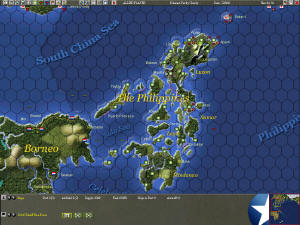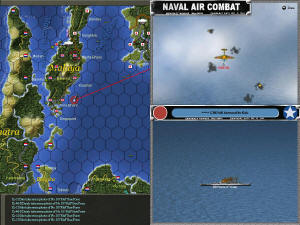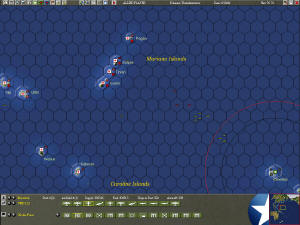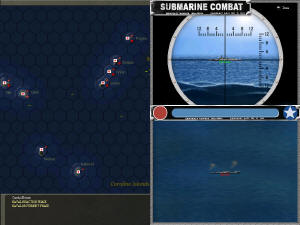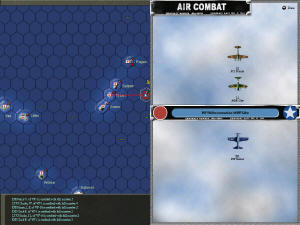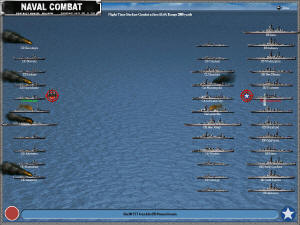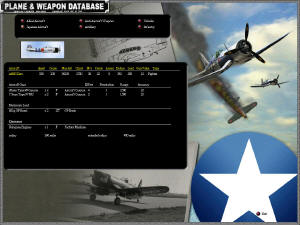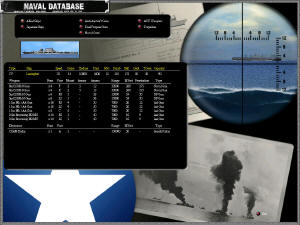|
|
||||||||
MAGNUM OPUS OF THE PACIFIC AN OVERVIEW OF WAR IN THE PACIFIC, FROM MATRIX GAMES
The Allies proclaimed a "Germany first" policy and devoted most of their resources to defeating the Nazis before turning on Japan. It made a lot of sense, as Germany was a direct threat to two out of three major Allied powers, the USSR and Great Britain, whereas Japan was not about to drive either out of the war, or the United States for that matter. It was conceivable that the Japanese could invade India or Australia, either of which might have been disastrous for the Allies, but as a cause the British Commonwealth and the Allies as a whole would have survived. Thus they decided to stage a net holding action against the Japanese, and when they went on the offensive, it was with far less land forces than were devoted to Europe; the American effort particularly was a navy show, using ships better employed in the wide expanses of the Pacific than against the paucity of naval power that Hitler could put to sea. That Franklin Roosevelt and Winston Churchill intended to be a secondary theater might explain why there have been relatively few Pacific board and computer wargames compared to those on the European Theater of Operations. In itself it does not explain why the war against Japan has to be so complicated for designer and player alike. What does explain its complexity is the wide variety of environments, contexts, and scales in which it was conducted. For the Americans, the fleet was the thing, and airpower the arm of the decision, especially when borne by aircraft carriers. Ground units were committed as divisions or smaller units, corps at the largest. Only toward the end, in the Philippines and Okinawa, could one see Americans conduct anything resembling European-scale ground warfare or maneuver. For most of the war units took points, not expanses of territory. To the east, the Commonwealth fought over greater areas in Malaya and then Burma. Their theater was a largely forgotten one compared to North Africa and Northwest Europe, but the polyglot mix of British/Indian/Gurkha/African/Australian units came to fight in a combination of larger numbers and denser concentrations than typified American operations. To the north was China, in which the territories contested and troops supposedly engaged were exceeded only by the political problems of dealing with Chiang Kai-shek and his Communist rivals, who often appeared more interested in saving resources to fight each other later than fighting the Japanese now. The Soviet Union was neutral until the last days of the Pacific War, concentrating its efforts on defeating Germany on its own, and then German, soil in the Great Patriotic War. When Josef Stalin did intervene as a fully participating and opportunistic Allied power, he unleashed an overwhelming, mechanized Red blitzkrieg on Manchuria. The Soviet army had learned the operational art in the hard school of the Eastern Front, and demonstrated its expertise by decisively overrunning the Japanese in a massive land campaign. No wonder Japan's war is such a complicated subject. In some instances it had linear land operations, but in many cases, especially those involving the United States, it was neither linear nor primarily land-oriented. Troops fought in the jungles of Guadalcanal and Burma, but also in the streets of Manila. Even in Pacific Island invasions, there was a world of tactical differences between attacking a coral atoll without depth such as Tarawa, or going after a larger, mountainous island such as Guam or Leyte. A designer has to take all into account. Furthermore, he has to present the player with at least some taste of the differences. There is also the matter of pace; much of the war saw a relative lack of activity on one or more fronts, punctuated by short periods of frantic, bloody activity. Other times there were long, bloody, attritional struggles, such as Guadalcanal or Sir William Slim's victories on India's eastern border. Finally, logistics was at least as critical as in any other theater, and considering the effects of the American submarine war, a decisive element. The Silent Service starved Japan to death. At the same time, railroads do not run underwater, and all sorts of units required their beans, bullets and benzene delivered by ship. That goes for the ships themselves; fuel oil does not materialize by magic on some island in the middle of nowhere. The evidence is convincing that simulating the Pacific War is nearly impossible, at least in a manner that both does justice to the subject and can be played. Occasionally a designer shows that the evidence is wrong however, as Mark Herman did with his Pacific War monster boardgame for Victory Games in 1985. Few gamers have the time, attention span or perhaps obsessive compulsive nature to play it to conclusion from Pearl Harbor to the bitter end, but it has plenty of battle and campaign scenarios, the latter with much strategic substance. On the computer side, there is War in the Pacific, released in June 2004. This game is a Windows-based work from Matrix Games and 2 By 3 Studios, and is designed by the experienced team of Gary Grigsby, Joel Billings and Mike Wood, with David Heath of Matrix Games. War in the Pacific builds on what has come before. There is some resemblance to Herman's Pacific War, most apparent in the map perspective and scope, and it has a similarly detailed order of battle for ground units, though it exceeds its detail when it comes to ships and aircraft. Whereas Herman consolidates his destroyers, light cruisers and light and escort carriers into groups of two or more vessels, for example, War in the Pacific uses the personal computer's processing ability to keep them as individual units, with many more distinct ratings and status metrics. Additionally, the boardgame has more generic air units, broken down according to the number of engines, and quality ratings, which can go up with time and national experience. War in the Pacific continues what it does for ships by breaking them down into a plethora of individual models, and among squadrons' strength is measured in terms of the number of planes available. Neither addition of detail is unprecedented in a game of World War II in the Pacific. Pacific War shares a title with Herman's boardgame, but is a computer game first published by SSI, and is now available as a free download from Matrix Games. It should also be noted that it was designed by Mike Wood, also behind War in the Pacific, and Mike Heath when it passed to his company. The orders of battle, maps, and general approach are clearly antecedent to War in the Pacific. However, the computer Pacific War has one major problem that has prevented it from aging well: It remains a DOS-based game, only now it can be started better in Windows than it could before. It has also been developed better over the years, with a steadily progressive search and destroy mission against programming bugs and play anomalies. But it is a DOS game nonetheless, and that interface is anachronistic, clunky, ugly, and wholly unsatisfactory in this millennium. The third ancestor is Uncommon Valor. Published in May 2002 by Matrix and designed by the able team of Keith Brors, Grigsby, Wood and Heath, it concentrates on the struggle for the South Pacific in 1942 and 1943. It broke with Pacific War for the PC by offering a Windows environment, visually stunning maps, and a far improved player interface. It also offers a wealth of scenarios on the campaigns for the Solomons, New Guinea and Bismarck Barrier. INTERFACEAt first glance, War in the Pacific resembles Uncommon Valor writ large. That description actually turns out to be extremely accurate, as they share virtually identical interfaces, and a player practiced in Uncommon Valor will find picking up War in the Pacific to be extremely easy. If one can use units and plan missions in one game, one can do the same in the other. Maybe the biggest difference between the two is that on the operational map, the menu buttons for War in the Pacific are at the top of the screen instead along the left. The basic mechanic for doing anything is to select a unit, assign a task, and then pick the particulars, which can be but are not necessarily the destination or target. Both games permit the player to leave such matters to the local commander, leaving the gamer to attend to the bigger strategic picture in his role as a theater commander. This proves to be more historically accurate anyway, as in general theater commanders would be more concerned with exercising sea control, air superiority, or contesting territory than they would be with the load-outs and targets of specific air squadrons. Subordinate commanders are hired for a reason, and War in the Pacific is ready to provide them. Yet the player can intervene when he wishes and assign priority in targets as well as in mission types to air units. When it comes to naval tactics, the computer always has more control than the player when fleets collide. Some might not like being relegated to spectator status, but this is one place in which no overall commander is ever going to intervene over the decisions of a local admiral or captain. Some decisions too are definitely above the gamer's pay grade, and the computer handles them too. In a title that covers the entire Pacific War, there will be economic production, and that will be the purview of the software. So too will be reinforcements and unit upgrades; the player has control over his war, but has to fight it with what his political leaders give him. Graphically, War in the Pacific follows the precedent set in Uncommon Valor for visually stunning maps and attractive icons. Some aspects of the interface are also uncommonly good, such as a general practice of allowing the player to sort lists of units along any of several criteria, such as ID or type for example, very welcome when there are large concentrations of forces on important bases. As soon as one tries to find a specific ship among more than a hundred in a harbor, the gamer finds out just how good this measure is. Perhaps the only thing that one might question is that the buttons on the unit and task force dialogues are unusually small. One quickly becomes accustomed to hitting the little target with the big mouse cursor, but it would have been preferable to extend the selection to the name of the choice too, so that clicking on that would be the same as clicking on the button. Then again, this criticism is probably no bigger than the buttons themselves. BREADTHThe question stands: What exactly does War in the Pacific cover? The answer is one simple word: Everything. At least everything beginning at Pearl Harbor. The pre-attack China Incident and Nomonhan battles are not within its scope, and in fact, the scenario editor does not permit a user to backdate the game to a date before 7 December 1941. The map has a scale of sixty miles per hex, and a perspective similar to the boardgame Pacific War, but manages to cover an even greater expanse of conflict. The map area is huge, covering all of the Pacific that could have been incorporated into the Greater East Asia Co-Prosperity Sphere, and then a lot more, including all of Australia, New Zealand, India, and China. There is also the Indian Ocean, into which the Japanese raided, and the map takes that as far as the Arabian Sea. War in the Pacific extends its reach further into North America to a much greater degree, showing a lot more than just the Aleutians. This game has virtually all of Alaska and the West Coast of the United States and Canada, extending deep inland. The Japanese might stand little chance of hoisting the Rising Sun flag over Los Angeles or Vancouver, but there is nothing to say that they might not launch a carrier raid on either. Besides, the West Coast is a place where reinforcements can enter the largest scenarios, and it having it in play gives the Allied gamer choices in how much he diverts to defending his heartland from Japanese attack. That the coast is in play shows that it has to be defended; to what extent is up to him. Not that all scenarios take place on a scope reaching from Karachi to San Diego. Many are fought in smaller areas. Still, having such a huge canvas remains a boon, as it makes a huge section of the globe available to scenario designers. Furthermore, unlike Herman's work, this game assigns a potentially active role to the Soviet Union, and does not relegatenit to the part of an invisible menace to be kept at bay by Japan through the maintenance of an adequate garrison in the northern Asian mainland. The Soviet Union's order of battle and weapons database are just as fully developed as those of Japan, Britain or the United States. It is just that the Russians do not enter the action as frequently as the other Allies, and when they do, it is as a definitely land-based power. In one way the computer game does better than the boardgame. Pacific War takes a fairly simplistic view of terrain, and along the way loses track of rivers as militarily significant features. This was always one of that game's questionable features, as it is a little hard to ignore the Yangtze, Mekong and Ganges. War in the Pacific does not make this mistake. Its portrayal of terrain is much better, and there are rivers, along with transportation routes, plus the expected mountains, jungles and cities. DEPTHComputers offer detail, and then the ability to work with it without becoming overwhelmed. At their core computers are counting machines, and enable a game to count squads, vehicles, airplanes and ships, all without giving the player the burdens of all that counting. He can move and fight with big units, and have the consequences expressed in an ultra detailed manner. Sometimes too the computer's capacity for detail gives him the ability to drill down below the usual layer of command represented by his role in the game. Thus a player who usually commands a group of battalions might give orders to companies or platoons, or even lower echelons. War in the Pacific's expression of detail is more of the first variety. Air squadrons cannot be broken down into smaller units, but the player can see how many aircraft are operational, in reserve or operational. At sea, he has ultimate control over every ship in the conflict, from PT boats up to Yamato and Iowa-class battleships. He can organize them into task forces of widely varying size, from one to a hundred ships, depending on the mission. Much like the Operational Art of War series from TalonSoft and now Matrix, War in the Pacific has units in which strength and status are represented in terms of individual aircraft, vehicles, guns and squads. This is just as important for ground units as it is for airpower. If the computer enables units to be represented with a high degree of granularity with no extra burden to the player, the time scale is something else again. It is another expression of depth, but one that while ultimately worthwhile, does add enormously to playing time and the need for patience and an attention span longer than usual. This massive war is simulated with turns as short as one day per turn, and no longer than a week. Within them there are segments in which daylight and night time action is differentiated, important especially for capturing the character of episodes such as Guadalcanal, in which the "Cactus Air Force" ruled the skies but the Imperial Japanese Navy held sway when the sun went down. Also, and even more critical, a great deal can happen in a very short time, so that a decisive moment such as Midway really does take place during an afternoon. Ultimately, the short time scale keeps War in the Pacific from playing like a strategic game a lot of the time. A player has to stay on his toes and mind details that, while small in themselves, add up to major elements of the strategic picture. It does make for a very long and complex game, however, and War in the Pacific has to rank Tora Tora Tora to Tokyo Bay probably has to invest hundreds of hours in the effort, and a lot more intellectual energy than he would in an equal time playing many other computer games. AIRSince so much of the Second World War in the Pacific was an air war at its core, it is wholly fitting that the game treats aerial conflict with a great deal of detail and sophistication. Sometimes those two concepts are not completely compatible, but they are in War in the Pacific. Airplanes are listed as individual components of squadrons. More unusual in any wargame, let alone one of this scope, is that so are the pilots. Collectively, the skill levels of the crews change over time. As losses mount, Japan's superb cadre of carrier aviators declines in quality, until they reach the awful state historically demonstrated in the Battle of the Philippine Sea. Ultimately, Japanese pilots are reduced to being little more than the human guidance systems for cruise missiles in the form of kamikazes. On the other side, Allied crews gain experience, and their training programs turn out a steady stream of ever-improving pilots. Individually, they have records and victories, and some are better than others. They can be wounded, killed and captured in combat. Some bail out and get rescued at sea. They also have names. One should not attach too much historical validity to this, as it is doubtful that anyone poured over the personnel records of all the units for every country, even had they been extent and available. But even random names are better than none at all, and they do tend to personalize the air war to a degree unknown in almost any other operational game, played on computer or cardboard. The planes that they fly are designated by make and model, sometimes with stunning specificity. Over time, just as pilot quality changes, so does that of their aircraft, usually for the better, as new ones become operational and reach the combat zones. Thus a unit that starts the war flying P-40 Warhawks might end up with the latest and greatest P-51 Mustang by the time it is all said and done. A Squadron is assigned a single mission, and often a secondary one, should it be unable to perform its primary task. This is extremely useful, as bombers given to attack enemy ships do not sit idle if the other side fails to cooperate, and no enemy vessels show up; if they have a secondary mission to attack airfields, for example, they will go after the enemy's air bases within reach. Commonly, squadrons have no specific target, and the local commander played by the software will decide what to target. The player can intervene and designate a task force or base to strike, which can be very useful at times. All of the most familiar missions are in the game. There is naval attack and patrol over water. Fighters escort other planes, though combat air patrols are handled automatically. Airfield and port attacks strike their respective facilities, and ground attacks target the opposition's ground forces. Transport planes carry troops or supplies, and any unit can rebase. War in the Pacific puts an unusual emphasis on photo reconnaissance. Few games give the recon mission much attention, putting their attention to shooting at people and dropping bombs on things. In this game, reconnaissance is vital to cut through the fog of war and gain intelligence against targets on land. Players who fail to divert units to this mission put the rest of their work at risk, attacking blindly, and they will find with less effectiveness too. SEAAny war that takes place over large expanses of ocean is going to have naval power as a key element, and War in the Pacific treats its ships just as elaborately as its planes. All go in task forces organized by the player, and are given a mission, a destination, and a choice of retiring to base upon its completion or remaining their on patrol. There is an even wider range of missions than for aircraft. But unlike air missions, those for task forces are altered in mid course, so that ships sent to bombard can be given a surface combat mission, which is one of the more common changes. The particulars of a mission can be changed too, including destination, a critical consideration as War in the Pacific does not permit the assignment of waypoints to task forces. The game makes coordinating multiple task forces easier through a button that orders one task force to follow another. A lot of operations require this; several carrier groups might operate together, and invasions typically involve several forces too. With the command to follow another task force, a player has to do little more than give a destination to one, and the others go right along. They might not always be in the same hex, due to different speeds and the problems of coordination, but they travel as close together as possible, and reach the same place eventually. Surface combat happens when task forces occupy the same hex, and the player mainly watches what the computer does. Night combat occurs at shorter ranges, and gives an extra advantage to the Japanese, due to the lethality of the Long Lance torpedo. Furthermore, one side might gain surprise over the other, and with it an early chance to shoot without without being shot at in return. Ships can also be engaged by air strikes, submarines, and again somewhat unusually in a World War II game, coast artillery. When one bombards an enemy base, the enemy gets to shoot back. This seldom does much against cruisers and battleships, well-armored platforms engaging from long distance, but if the player chooses to let escorts bombard too, they he soon finds out that destroyers pay a price for making the attack more effective. Lengthy bombardments do not readily pay off. The first attack will do a lot of damage and kill a lot of enemy troops, if there are a lot of enemy troops present, but with each round the returns decline, at no commensurate reduction in risk. Ship damage is treated in extraordinary detail, more in keeping with a tactical game. This is not like an early boardgame either, in which a warship would take a fixed number of bombs or shells and then sink without further debate. There is a lot more subtlety here. The main reason is that not all projectiles are created equal. A big ship might take a large number of shells, and even go on fire, but if they are from a destroyer it will mean very little. By contrast a thousand-pound bomb or sixteen-inch battleship shell landing on the deck of a destroyer is sure to be bad news. Regardless of the size of the weapon and the size and armor of the target, it takes more to sink a ship in War in the Pacific than in other games. Destroyers might take several bombs, not just one, and still remain afloat. It might not be by much, and it they will be crippled or nearly so, but they will be on the surface. As for battleships, it takes a much greater number of direct hits to do sink a target, and they should be from guns and bombs worthy of the target. Two techniques can be rated as the best for sinking warships. One is inflicting critical damage, through penetrating armor to spark explosions or cause severe damage below deck, with either bomb or shell. The other is the torpedo. Whether it comes from a sub, surface ship or aircraft (the riskiest and least likely delivery method), a torpedo is going to affect floatation, probably impeded speed, and generally hit the ship where it hurts. LANDGround forces are the third element of the game's triumvirate of forces, and like the others, are portrayed with detail, and give the player a great deal of control over their use. Units assume a defensive posture or offensive posture, and when they attack, it is with a tempo chosen by the side that controls them. There is a cost to the offensive too, and it is not just in casualties; they consume supplies at an accelerated rate, supplies that have to be replenished, possibly at some difficulty. The air rules give special credence to reconnaissance. On the landward side, the game gives special and altogether importance to engineers. In the long run, nothing would be done without them. During combat for fortified enemy bases, they are essential for reducing those forts. In rear areas, they become even more important, for their ability to build. They construct the player's own fortifications, and also build and expand ports and airfields. No base or amphibious operation is truly complete without them. Amphibious warfare is a special problem for a player, just as it was for the commanders in the Pacific. In fact, it is quite probably the most consistently difficult task in the game. It is not just a matter of getting a bunch of ships and landing craft, and carrying a bunch of troops to a hostile shore. it is a lethal ballet that involves airpower, naval power, and only culminates when the infantry and supporting arms are engaged. Some of the work seems obvious enough. Enemy airpower has to be neutralized or driven away, and sea control asserted. That is easy to figure out. It all becomes hard when loading the transports. The player has to put together a task force of the right composition, balancing transport capacity, assault shipping, and the fire support that will silence the other side's artillery long enough to get the troops ashore with minimal losses. Nor should one ever forget logistics. Nothing gets done without them. Ships can be loaded with troops only, but most of the time this a poor idea, as that gives them none of what they need to fight when they land. Otherwise, the game will fill out the excess space in a task force with supplies. Considering how many supplies it takes to fight aggressively, a gamer should make sure that there is plenty of excess space. Amphibious warfare, and sea transport of any ground units for that matter, exposes one of the rare systemic shortcomings of the game. The default setting for a transport mission is to permit retirement upon reaching the destination. When a ship is in port, the destination is the port itself. Therefore as soon as the troops are on the ships and ready to go, they will immediately get right off again. That is the primary effect. The secondary effects are lost time and player frustration. Thus when assigning a task force to transport, before he puts anybody on the ships, the player should make sure that he orders it to patrol and remain at the objective, either that or order it to proceed to the objective as soon as the last soldier steps aboard. It is an outwardly small thing, but in this game, a vital precaution to one of its most important missions. OPPONENTFrom the dawn of the computer wargame era, the software has been criticized often for its artificial intelligence. Truly, some titles have offered computerized opponents with all the military skill of Ambrose Burnside on peyote. This is not one of them. Rather, if it is open to criticism, it is for the exact opposite reason. War in the Pacific's artificial intelligence can be lot better than historical commanders, more sensible, and more aggressive, in sum more challenging. It does much to balance the game and make it enjoyable, but for history, it might be preferable to chose the easy setting instead of the historical one. The Marianas scenario is a case in point. Historically, the Japanese performance in the Battle of the Philippine Sea was beyond bad; the words inept, irresponsible and dysfunctional come to mind. This is no reflection on the pilots and sailors, who did the best the could in a bad situation against a power and ascendant foe, but their admirals. The game is liable to start off in an expected manner, as repeated Japanese strikes on the American carriers get shot out of the sky with ease, replicating the "Marianas Turkey Shoot." These are invariably land-based, from the islands themselves, and Ulithi, Yap and Palau, if the American fleet ventures close enough. The Japanese aircraft carriers though do not show up. Instead, the computerized Japanese admiral leads with his surface fleet, not his carriers. It is his strength and so it is a wiser decision that it might appear at first. The battleships and escorting cruisers and destroyers will go toward the American beachheads and try to engage the American warships there in a night battle, more like the Guadalcanal battles of two years previously. At the same time, the computer will try to sneak past the carriers to a surface engagement or bombardment, reminiscent of the plan historically conceived for the Battle of Leyte Gulf. This is not the only instance in which the artificial intelligence exceeds the performance of the real leaders, or at least comes up with a better plan than they do. To reveal more though would give away too many of the game's surprises and secrets. CONCLUSIONSWar in the Pacific does one thing very easily. That is to impress the skeptical critic. It is a superb game, one that fully takes advantage of what the computer offers in order to process detail, and make it visible to the player without any of it becoming a burden. Even if the practice of naming pilots is more for atmosphere than strict accuracy, the rest of the order of battle information is stunning in its inclusiveness and depth. There is nothing generic about any of the unit types, especially when it comes to aircraft. Playability is high too. This is belied by the manual, all two hundred and twenty pages of it, but the bulk of that is more a matter for reference than learning the essentials of the game in the first place. A player already familiar with Uncommon Valor will take to War in the Pacific easily, and if that experience is recent, immediately. There is not much not to like. Perhaps the biggest shortcoming is a shortage, of scenarios. War in the Pacific presents about half the world and four years of war, but only sixteen scenarios in all, including the large campaigns. More smaller ones lasting a few weeks or months would constituted a major improvement, above all if they covered more of the war's critical junctures. There is nothing that focuses on Midway, locally or combined with the Aleutian diversion, Nagumo's venture into the Indian Ocean, Singapore, or Leyte Gulf and the liberation of the Philippines. All would have been excellent additions had they been subjects for scenarios and not only parts of the larger campaigns. Uncommon Valor veterans will be struck by the fact that few of the situations simulated there make it into War in the Pacific. There is a simple remedy to that, it must be admitted: Just play Uncommon Valor instead. War in the Pacific is likely to rekindle interest in its predecessor in any case, and it should. Uncommon Valor is four years old now and is far from dated, let alone obsolete. There is a third game to the series too, War Plan Orange. It backdates War in the Pacific to the 1920's and 1930's, presenting an alternate history vision of the war that never happened, complete with cancelled ships and some dreadnoughts that were historically finished as aircraft carriers. It is worthy of attention and analysis in its own right, just as much as the others in its family. There are still some places in which the game system can be used to great effect. The missing scenarios to War in the Pacific would be a wonderful start. The rest of the Pacific War is petty well covered though, now that the alternate history angle has its own title. Most of the European theater is too big, too intense, and has too many huge concentrations of units to be as workable as the Pacific is. However, the War in the Pacific approach is worth exploring for the Mediterranean, including North Africa, Balkans and Italy. Having a protracted air and naval struggle for those waters adds to the appeal, as does a variety of military situations nearly as wide as against Japan. It also seems ideal for the invasion of Norway. This is such an excellent system that it can leave a player wanting more. The scenarios in the game already demand replay, as it often seems that there is something that can be done differently and better, and something to be learned. Hence the questions about amphibious warfare, and repeated attempts to learn the fine points of mounting an invasion. As a game and as a vision of history, War in the Pacific builds on the lofty standard that Uncommon Valor established, and expands it. Then it sets the table for War Plan Orange. In so many ways, this game is a winner. SCREEN CAPTURES |

